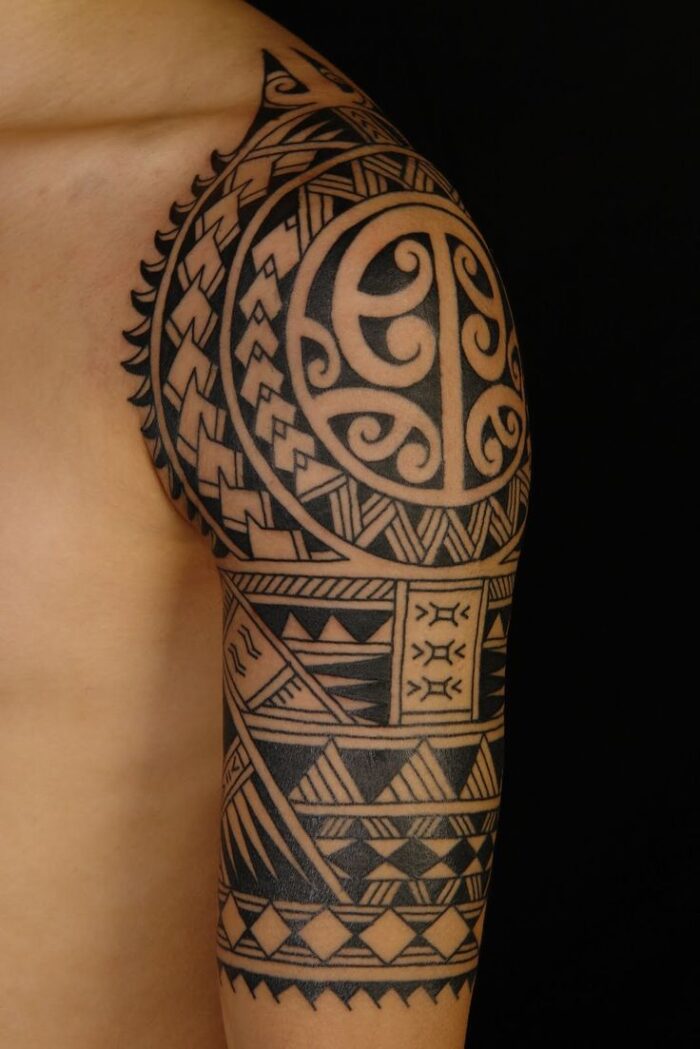For Native Hawaiians, Hawaiian tattoos, sometimes referred to as kakau, have great cultural and historical significance. For millennia, people have used these complex and symbolic patterns to represent their genealogy, position, protection, and life events. Hawaiian tattoos have had a significant resurgence in popularity along with the recent resurrection of Hawaiian culture.
Significance of Often Used Hawaiian Tattoo Designs
Typical Hawaiian tattoo art contains a lot of recurring themes and components. These are a few of the most well-liked designs along with their cultural connotations:
Turtles: Turtles stand for family, harmony, health, longevity, and reproduction. They were thought to be lucky charms for seafarers because of their capacity for ocean navigation.
Sharks: Sharks represent power, fortitude, protection, direction, and mana, or spiritual force. Since they protected the sea, they were revered.
Waves: Waves represent the ocean’s ability to sustain life as well as the continuity of past, present, and future generations. They represent resiliency, strength, and rejuvenation.
Tiki: Tiki statues are symbolic of the gods and ancestors of Hawaii. They stand for defence against demonic forces.
Lizards: Because they may shed their tails, lizards and geckos are symbols of self-preservation and regeneration. They are regarded as heavenly guides.
Hawaiian native flowers, such as plumeria, orchids, hibiscus, and anthurium, symbolise beauty, love, life, and birth.
Spearheads: In warfare, spearheads stand for bravery and might. Warriors wore them as representations of their strength.
Hawaiian Tattoo Traditions’ Resurgence
Hawaiian tattooing was outlawed following European encounter in the 18th century as a result of missionaries’ attempts to convert the islanders to Christianity. The ancient art form was all but gone by the 19th century. However, kakau returned because of the Hawaiian cultural renaissance that started in the 1970s. Native customs became the subject of a resurgence of curiosity and pride.
Intense effort has been made by contemporary artists to restore the traditional tattooing methods, supplies, and artwork. The age-old technique of tapping bones by hand using chisels made of bone and tusk has been maintained. In order to replicate real motifs, tattoo artists may make use of historical records and artefacts. But contemporary Hawaiian tattoos have also developed to include fresh motifs and visual aesthetics.
The Importance of Positioning
The placement of each pattern on the body had equal significance in traditional Hawaiian tattooing as the image itself. To respect one’s kuleana (duty) in the community, certain tattoos were applied. The following are some typical placements along with their definitions:
Forearms: Men used to frequently have forearm tattoos to denote their skill in sports like sailing, canoeing, fishing, dancing, and combat.
Shoulders to Elbows: Having a lot of tattoos on the arms and shoulders was a sign of power and high social standing. They were connected to warriors and chiefs.
Hands and Fingers: In order to provide protection during labour, recovery, and combat, tattoos were applied to the hands and fingers. It was believed that the patterns possessed spiritual force.
Tattoos on the torso commemorated important life events like as marriages, births, and conflicts. They preserved a person’s past.
Ankles and Feet: Foot and ankle tattoos represented a person’s life path and offered direction on travels. They granted safe return traveller.
The Lasting Imprint
Even though designs and methods have changed throughout time, Hawaiian tattoos retain the rich history, culture, and meaning that have been passed down through the ages. They provide a deeply intimate link between the wearers of today and their forefathers. Hawaiian tattoos are works of genuinely living art that depict a people’s history. I sincerely hope you find this “hawaiian tattoos” article helpful.

